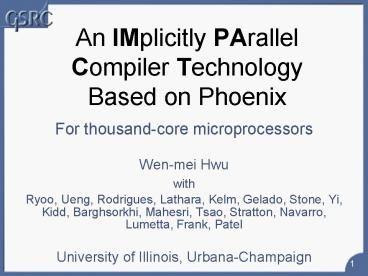For thousand-core microprocessors - PowerPoint PPT Presentation
1 / 19
Title:
For thousand-core microprocessors
Description:
Ryoo, Ueng, Rodrigues, Lathara, Kelm, Gelado, Stone, Yi, Kidd, Barghsorkhi, ... Infrastructure work has slowed down ground-breaking work ... – PowerPoint PPT presentation
Number of Views:18
Avg rating:3.0/5.0
Title: For thousand-core microprocessors
1
An IMplicitly PArallel Compiler Technology Based
on Phoenix
- For thousand-core microprocessors
- Wen-mei Hwu
- with
- Ryoo, Ueng, Rodrigues, Lathara, Kelm, Gelado,
Stone, Yi, Kidd, Barghsorkhi, Mahesri, Tsao,
Stratton, Navarro, Lumetta, Frank, Patel - University of Illinois, Urbana-Champaign
2
Background
- Academic compiler research infrastructure is a
tough business - IMPACT, Trimaran, and ORC for VLIW and Itanium
processors - Polaris and SUIF for multiprocessors
- LLVM for portability and safety
- In 2001, IMPACT team moved into many-core
compilation with MARCO FCRC funding - A new implicitly parallel programming model that
balance the burden on programmers and the
compiler in parallel programming - Infrastructure work has slowed down
ground-breaking work - Timely visit by the Phoenix team in January 2007
- Rapid progress has since been taking place
- Future IMPACT research will be built on Phoenix
3
The Next Software Challenge
Big picture
- Today, multi-core make more effective use of area
and power than large ILP CPUs - Scaling from 4-core to 1000-core chips could
happen in the next 15 years - All semiconductor market domains converging to
concurrent system platforms - PCs, game consoles, mobile handsets, servers,
supercomputers, networking, etc.
We need to make these systems effectively
execute valuable, demanding apps.
4
The Compiler Challenge
Compilers and tools must extend the humans
ability to manage parallelism by doing the heavy
lifting.
- To meet this challenge, the compiler must
- Allow simple, effective control by programmers
- Discover and verify parallelism
- Eliminate tedious efforts in performance tuning
- Reduce testing and support cost of parallel
programs
5
An Initial Experimental Platform
- A quiet revolution and potential build-up
- Calculation 450 GFLOPS vs. 32 GFLOPS
- Memory Bandwidth 86.4 GB/s vs. 8.4 GB/s
- Until last year, programmed through graphics API
- GPU in every PC and workstation massive volume
and potential impact
6
GeForce 8800
- 16 highly threaded SMs, gt128 FPUs, 450 GFLOPS,
768 MB DRAM, 86.4 GB/S Mem BW, 4GB/S BW to CPU
7
Some Hand-code Results
App. Archit. Bottleneck Simult. T Kernel X App X
H.264 Registers, global memory latency 3,936 20.2 1.5
LBM Shared memory capacity 3,200 12.5 12.3
RC5-72 Registers 3,072 17.1 11.0
FEM Global memory bandwidth 4,096 11.0 10.1
RPES Instruction issue rate 4,096 210.0 79.4
PNS Global memory capacity 2,048 24.0 23.7
LINPACK Global memory bandwidth, CPU-GPU data transfer 12,288 19.4 11.8
TRACF Shared memory capacity 4,096 60.2 21.6
FDTD Global memory bandwidth 1,365 10.5 1.2
MRI-Q Instruction issue rate 8,192 457.0 431.0
HKR HotChips-2007
8
Computing Q Performance
446x
GPU (V8) 96 GFLOPS
CPU (V6) 230 MFLOPS
9
Lessons Learned
- Parallelism extraction requires global
understanding - Most programmers only understand parts of an
application - Algorithms need to be re-designed
- Programmers benefit from clear view of the
algorithmic effect on parallelism - Real but rare dependencies often needs to be
ignored - Error checking code, etc., parallel code is often
not equivalent to sequential code - Getting more than a small speedup over sequential
code is very tricky - 20 versions typically experimented for each
application to move away from architecture
bottlenecks
10
Implicitly Parallel Programming Flow
Stylized C/C or DSL w/ assertions
Deep analysis w/ feedback assistance
Concurrency discovery
Human
For increased composability
Visualizable concurrent form
Systematic search for best/correct code gen
Code-gen space exploration
For increased scalability
Visualizable sequential assembly code with
parallel annotations
parallel execution w/ sequential semantics
Parallel HW w/sequential state gen
For increased supportability
Debugger
11
Key Ideas
- Deep program analyses that extend programmer and
DSE knowledge for parallelism discovery - Key to reduced programmer parallelization efforts
- Exclusion of infrequent but real dependences
using HW STU (Speculative Threading with Undo)
support - Key to successful parallelization of many real
applications - Rich program information maintained in IR for
access by tools and HW - Key to integrate multiple programming models and
tools - Intuitive, visual presentation to programmers
- Key to good programmer understanding of algorithm
effects - Managed parallel execution arrangement search
space - Key to reduced programmer performance tuning
efforts
12
Parallelism in Algorithms(H.263 motion
estimation example)
13
MPEG-4 H.263 EncoderParallelism Redicovery
(b)
(c)
(d)
(e)
(a)
14
Code Gen Space Exploration
15
Moving an Accurate Interprocedural Analysis into
Phoenix
Unification Based
Fulcra
16
Getting Started with Phoenix
- Meetings with Phoenix team in January 2007
- Determined the set of Phoenix API routines
necessary to support IMPACT analyses and
transformations - Received custom build of Phoenix that supports
full type information
17
Fulcra to Phoenix Action!
- Four step process
- Convert IMPACTs data structure to Phoenixs
equivalents, and from C to C/CLI. - Creating the initial constraint graph using
Phoenixs IR instead of IMPACTs IR. - Convert the solver pointer analysis.
- Consist of porting from C to C/CLI and dealing
with any changes to Fulcra ported data
structures. - Annotate the points-to information back into
Phoenix's alias representation.
18
Phoenix Support Wish List
- Access to code across file boundaries
- LTCG
- Access to multiple files within a pass
- Full (Source code level) type information
- Feed results from Fulcra back to Phoenix
- Need more information on Phoenix alias
representation - In the long run, we need highly extendable IR and
API for Phoenix
19
Conclusion
- Compiler research for many-cores will require a
very high quality infrastructure with strong
engineering support - New language extensions, new user models, new
functionalities, new analyses, new
transformations - We chose Phoenix based on its robustness,
features and engineering support - Our current industry partners are also moving
into Phoenix - We also plan to share our advanced extensions to
the other academic Phoenix users































